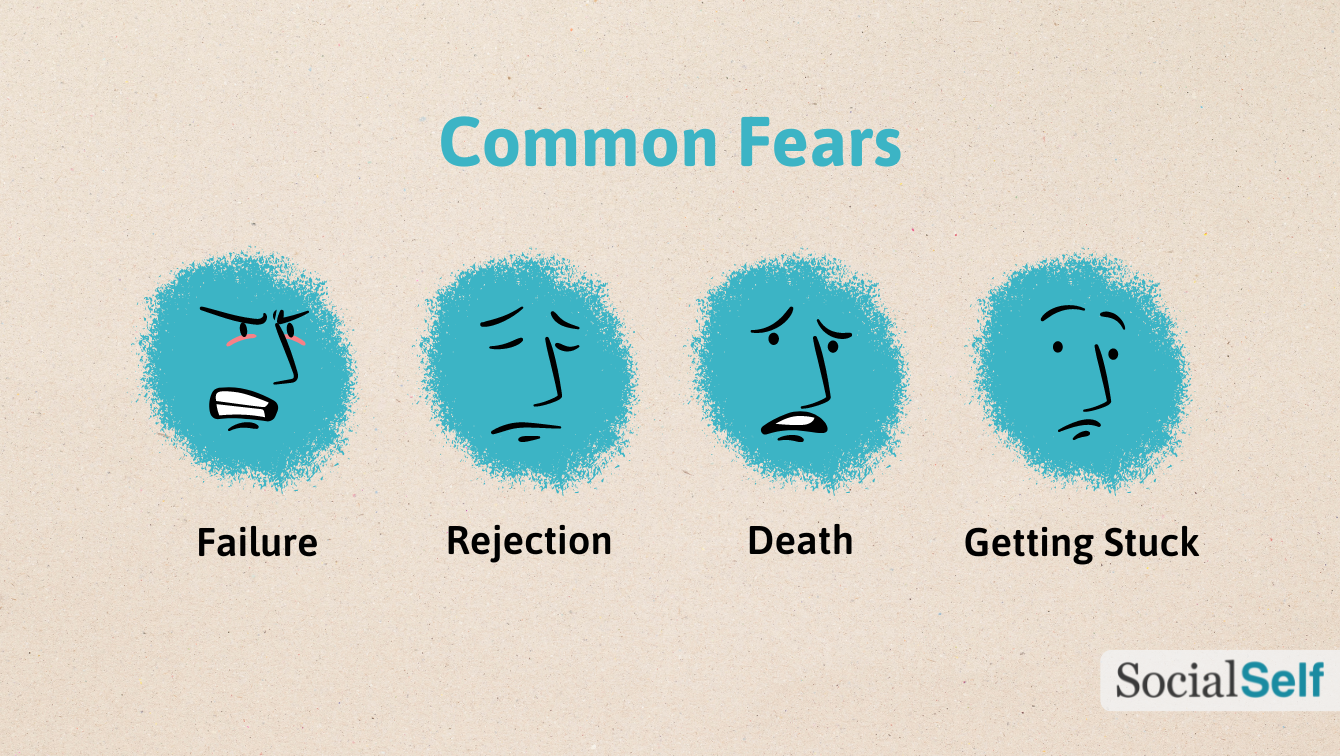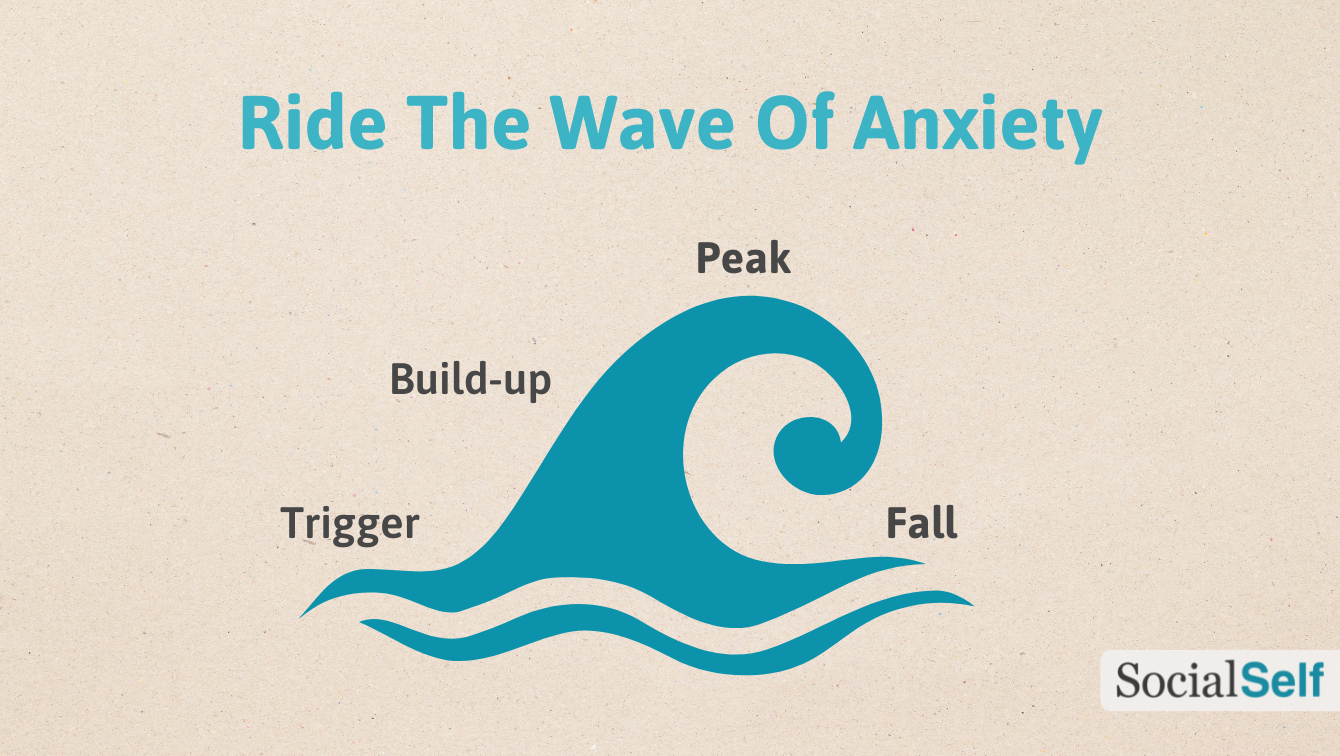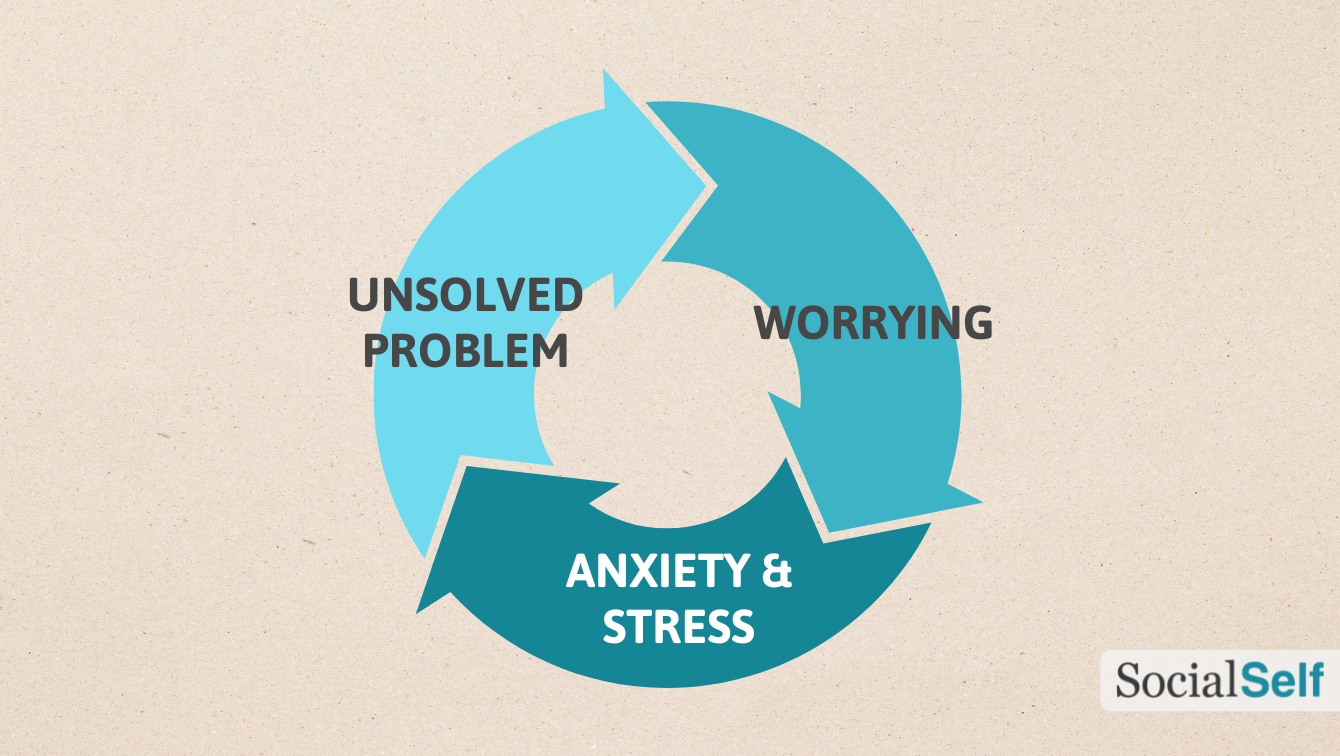Worrying is the anxious habit of imagining bad things that might or could happen, even when they’re unlikely to occur. While everyone occasionally worries about things, worrying too much can diminish your quality of life.
Over time, worrying can have adverse effects like increased stress and anxiety, and it can even cause health problems. Most people who worry too much don’t know how to stop, but there are skills and strategies that can help you change this bad habit.[1][2]
This article will outline what worrying is, how it can affect you, and what you can do to interrupt this bad thinking habit before it affects your quality of life.
Sections
- What is worry?
- How to stop worrying: 15 proven tips
- Why is it so hard to stop worrying?
- Why worrying is bad for you
- Common questions
What is worry?
Worrying is the mental habit of giving too much time, energy, and attention to certain negative thoughts. These negative thoughts are usually fear-based and may include overthinking things that have already happened or things that haven’t happened yet.[1][2] For example, someone might worry about their partner cheating, messing up an important project at work, or the death of a loved one.
These kinds of fears are normal, and everyone sometimes has them, but worriers aren’t able to let them just come and go. Instead, they will think about them in an obsessive way, even when there isn’t any proof that they’re likely to happen.[3] Some people are consumed by worrying thoughts like this and are unable to focus on anything else when they arise.
How to stop worrying: 15 proven tips
It is possible to train your brain to stop worrying, but it takes time, practice, and patience. Because worrying is often a bad habit years in the making, it’s unrealistic to expect to be able to change this habit overnight. It’s also important to understand that these skills won’t eliminate your fears or stop the negative self-talk in your mind, but they can make them less noisy.[1][2][3]
Below are 15 proven tips and strategies to help you interrupt worried thoughts and break this bad mental habit.
1. Name your fears
A lot of worries gain power by remaining anonymous or mysterious, so naming your fears takes some of this power away. Naming a fear can put a small worry or concern into context, helping you recognize that the thing you’re worrying about isn’t that big of a deal. For example, if you’re stressing about a first date, it’s probably really about a fear of rejection.

By naming this as a fear of rejection, you might be able to interrupt ten seemingly different scenarios that are all different versions of this same fear. Other common root fears include fear of failing, dying, and being trapped. Knowing what you’re afraid of can help you understand that most of your fears and worries repeat themselves, only making slight changes to the circumstances.
2. Understand why you’re scared
After you name your fears, the next step is to work on understanding them. Remember that “you scare where you care,” and each fear represents something that you need, want, or care about. If there was nothing important at stake, you wouldn’t be worried or scared. This means you can use your fears to better understand your values.
Here are some examples of ways to reverse engineer your fears to find out more about your core values:
- Fill in the blanks of this sentence: “I’m only afraid of __________ because I care so much about ____________”
Example: “I’m only afraid of failing at work because I care so much about my career.”
- Name antonyms or opposites of your fear until you find a word that represents something that feels really important to you.
Example: Antonyms of stuck include freedom, growth, autonomy, independence, progress, goals, direction, and purpose.
- Figure out what you really need or want in a situation that is worrying or scaring you.
Example: “I’m freaking out about having a difficult conversation with my friend because I really want to be able to work through this and stay friends.”
3. Stop feeding stray worries
When you feed your fears with lots of examples of things that could go wrong or bad things that could happen, they will get bigger. These kinds of scary stories are like food for your stray fears—they make them bigger and keep them around longer.[1][3]

If you don’t want your fears to stick around for so long, try not to feed them as much. Here are some examples of thoughts and stories that are like “food” for your fears:
- Making a mental list of all of the worst-case scenarios before a vacation.
- Researching rare health conditions whenever you have a rash.
- Personalizing horror stories of bad things that happened to other people.
- Creating hypothetical zombie apocalypses, wars, and famines in your mind.
- Letting your imagination write a psycho serial killer profile for a new neighbor.
4. Switch your “what if’s” to “even if’s”
A lot of your worries may begin with “what if…” scenarios about the future. When there’s an unknown, it’s natural for your mind to want to fill in the blanks, and when you’re afraid, it’s normal to think of the worst possible outcome. One way to interrupt this cycle of worry is to change your “what if” thoughts into “even if” thoughts.
This simple technique is borrowed from Cognitive Behavioral Therapy (CBT), which is one of the most proven treatments for anxiety. By reframing your anxious “what if” thoughts to “even if” thoughts, you cue your mind to work in a more productive way. Instead of just listing the negative things that might happen, you can instead identify what you would do if that did happen.[1]
5. Feel your feelings
Feelings (including fears) are meant to be felt in your body, not logically processed in the mind. Most people who experience a lot of anxiety make the mistake of trying to think their way out of their feelings, which only gets them more stuck.[3] A better, faster way to process emotions is to feel them in your body.

If you’re not sure how to feel your feelings, try the following steps:
- When you’re worried, tune into your body and try to pinpoint where you’re feeling the fear (e.g., your stomach, chest, throat, etc.).
- Take a few big, deep breaths and imagine each breath in is opening up and creating more space for this emotion, and each breath out is releasing tension.
- Track the sensations you feel in your body and keep your attention trained on these feelings until they pass (e.g., imagine a ‘wave’ of fear rising up, cresting, and finally subsiding).
6. Be proactive to work toward the outcome you want
When you worry, you spend a lot of time and energy thinking about the outcomes you don’t want. A better use of this time and energy would be to work towards an outcome you do want. By taking proactive steps towards the outcomes you want, you actually are working to make this outcome more likely, and the one you don’t want less likely to occur.[1]
For example, instead of spending hours worrying about cancer or other medical diseases you might be diagnosed with, you could instead use this time to develop healthier lifestyle habits. For example, working out more, getting enough sleep, and eating foods that nourish your body (vs. just junk food and empty calories) all improve your health and can even add years to your life.
7. Zoom out to see the big picture view
It’s really easy to get too focused on a small problem or concern, but zooming in too much can make these problems feel a lot bigger than they actually are. A good way to bring your problems back to scale is to zoom out and take a big-picture view. This is another CBT reframing skill that can help you put your worries in context.[1]
Here are some ways to zoom out and see the big picture view when you’re too focused on something small:
- Ask yourself if this problem or issue will still matter 1 year, 5 years, or 10 years from now.
- Compare this issue to other, bigger problems you’ve had to overcome in your life to remind yourself how strong and capable you are.
- Make a list of some of the bigger, more important, and more positive things you have going on in your life to get more context.
8. Talk about your fears with someone you trust
Another way to take some power away from your worries is to talk openly about them with people you trust. By doing so, you take your fears out of the echo chamber of your mind and can get some rational input from people who know and love you.
Sometimes, a fear will sound so ridiculous when we say it out loud that it just becomes something funny we can laugh off. Other times, talking with someone we trust can help us to work through our fears in a more level-headed way while also getting some emotional support at the same time.[4]
If you struggle to talk about emotions, you might like this article on how to be more expressive.
9. Summon your courage and do something brave
Courage is the best antidote for fear and always involves being afraid but doing something anyway. Being brave doesn’t shrink your fears, but it does make you bigger and stronger, meaning your fears feel smaller.[1][4]
Even small acts of courage can help you feel braver, stronger, and more confident. The specific acts of courage that will help you the most depend on the fears you have. Here are some examples of ways to be brave in the face of common fears:
- Face fears of rejection by speaking up more, introducing yourself, talking to strangers, asking people on dates, or messaging people on a friend app.
- Face fears of failure by taking more shots, being OK with making a mistake, laughing it off, and always getting back up and trying again when you miss a shot.
- Face fears of commitment by keeping your word, following through on promises you make to yourself and others, and telling people close to you how you really feel.
10. Focus on what you can control
One of the biggest mistakes that can lead to worry is focusing on things that are beyond your control to stop, change, or fix. In any bad situation, there are always some aspects that are within your control, and staying focused on these can help you avoid the worry trap.[1]
Here are some examples of ways to refocus on things within your control:
- Use an “If-then” formula to come up with a plan
Example: “If I lose my job for some reason, then I will contact people from my old company and see if they have openings”
- Focus on your response to a situation rather than the situation itself
Example: “I can’t control the price of gas, but I can work on tightening up my budget to have more wiggle room if I need it.”
- Focus on what you want to say instead of how people will respond
Example: “I don’t know how my boss will respond, but I need to make it clear that I’m feeling really overwhelmed and could use another person on my team.”
11. Manage your stress levels
Stress and anxiety often come in pairs. Both stress and anxiety feed off one another, which is why it’s important to manage your stress levels if you’re trying to control your worry and anxiety. By keeping your stress levels low, you’ll find that you’re less anxious and more able to control your worrying thoughts.[1][2][4]
Here are some proven tips for managing and reducing your stress:[1][2][4]
- Be more physically active: Physical activity and exercise are proven to decrease levels of stress hormones and reduce stress and anxiety.
- Make time to meditate: Meditation is another proven stress and anxiety-busting activity, and even carving out 15 minutes a day for a guided meditation can help you de-stress.
- Stick to a sleep schedule: Getting 7-8 hours of sleep a night is crucial for both your physical and mental health and is proven to help lower stress and regulate your mood.
- Avoid drugs and alcohol: Mind and mood-altering substances (including alcohol) can provide immediate relief from worry but can make anxiety worse in the long run.
- Connect with others: Push yourself to be more social and spend more time with people you care about—it helps your mood and lowers your stress.
12. Be proactive and work for the outcome you want
Anxiety usually occurs when you don’t feel like you have control or certainty, which is why being proactive can help to interrupt worried thoughts and feelings.[1][3][4] Coming up with a plan and being proactive can reduce your anxiety and is much more productive than worrying.
By being proactive, you can often make the bad outcomes you worry about less likely, and the outcomes you want more likely. Even when things don’t go exactly as planned, having a plan and being proactive still helps you feel more in control.
13. Be kinder to yourself (in words and actions)
Some people who worry too much are also very self-critical and always focus too much on their weaknesses, flaws, and mistakes. Self-criticism is another bad habit that can increase your self-doubt, stress, and anxiety, which all make you more likely to worry.
Research shows that people who are self-compassionate are less anxious, stressed, and depressed.[5] They are also healthier.[5] If you’re not sure where or how to begin being kinder to yourself, here are a few ideas:
- Journal about things you’re proud of yourself for or appreciate about yourself.
- Practice speaking positively to yourself, like you would speak to a friend or loved one.
- Prioritize your physical and emotional needs on a daily basis.
- Set better boundaries with people to avoid being taken advantage of.
14. Let go of worries you can’t control
Not every worried thought needs to captivate your time and attention, especially if it’s something you can’t do anything to stop, change, or even predict. Letting go of things that worry you but aren’t within your control can be a very freeing experience. It helps you be more in control of what goes on in your mind instead of feeling held hostage by your thoughts.
Here are some tips on how to let go of worrying thoughts when you’re ruminating on them:[1]
- When a worrying thought pops up, ask yourself, “Is this something I can control?”
- When the answer is no, imagine the thought is a balloon and visualize yourself letting go of the string.
- Redirect your attention to something else (e.g., another thought, a task you’re doing) each time the balloon enters back into your mind.
15. Be more intentional with your time and energy
Time and energy are a form of currency. Each task, thought, or experience you devote time and energy into is like an investment. Similar to actual investments you make with your money, there are wise investments that pay you back and then unwise ones that give little or nothing back.
Think of worries like an unwise investment—they can take a LOT of time and energy, and they rarely pay any of that back.
When you waste time and energy, you are literally wasting your life, and not just your money (which can be earned back). When you begin thinking in these terms, you start to see that worrying is an enormous waste of your life. The question is, what would you rather be investing that time and energy into? For most people, the wisest investments of time and energy include:[4]
- Spending more quality time with the people you love and care about
- Doing more of the activities that bring you joy
- Going on more adventures (e.g., traveling, trying new things, etc.)
- Setting and working towards important goals
- Doing good in the world or helping other people
- Sharing your ideas or being creative
- Activities that are meaningful or connect you to your beliefs and values
Why is it so hard to stop worrying?
Worrying is hard to stop because it is the brain’s way of trying to help us feel less afraid. Worrying happens in the same areas of the brain that solves problems, makes plans, and helps with decision-making.
This part of the brain is great at working with facts but not so great at working with feelings. It’s even more difficult for this part of the brain to deal with worrying thoughts and feelings because there often isn’t an identifiable “problem” to solve. This causes the mind to get stuck ruminating and repeating negative thoughts that feed into stress and anxiety.[1][3]

For example, many worried thoughts are about things that might or could happen in the future instead of things that have already happened. Because there are so many unknown variables, this critical thinking part of the mind gets stuck filling in the blanks with different scenarios, almost all of them bad.
This can become an endless cycle of worry that gets people stuck in their heads. It also creates more stress and anxiety, which further fuel the cycle of worry. Worry is often the result of the logical part of your brain wanting to give you a concrete answer or solution without enough data or facts to do so.[1]
Why worrying is bad for you
When you do it too often, worrying is bad for both your physical and mental health. Worried thoughts can activate your nervous system and pump stress hormones like cortisol and adrenaline into your bloodstream. This causes a fight or flight response, which makes your heart rate and breathing change, making you more alert and on edge during times when you’re afraid.[1]
When this only happens occasionally, it usually isn’t a problem. However, having your fight or flight response activated too often places your body and your brain in a state of chronic stress. Worrying can keep you in this fight or flight state for long periods of time.[1][3]
Chronic stress, anxiety, and worry can create mental health problems like anxiety disorders. They can even make you more susceptible to getting sick or developing a chronic health problem. Worrying also can impact your quality of life by making it difficult to focus or be present during your interactions and experiences, even the positive ones.[1][2][3]
Final thoughts
If you worry too much, you probably get stuck in your head a lot, fixating on thoughts that cause stress and anxiety.[3] Worried thoughts can interfere with your relationships, affect your choices, and can lower your quality of life.[1][2][3] The good news is that this habit can be unlearned using the tips in this article. While you can’t eliminate your worries, you can choose not to give them as much power over you and your life. This way, you can start worrying less and living more.[1]
Common questions
How do I train my brain to stop worrying?
You can train your brain to stop worrying by changing your response to worrying thoughts. When a worrying thought pops into your mind, try to refocus your attention on something in the present—for example, where you are, what you’re doing, or what you can see or hear.[1][4]
What is the 333 rule for anxiety?
The 3-3-3 rule is a grounding technique that can help you focus your attention on the present moment by listing 3 things you can see, hear, and touch. This technique works by training your brain to focus outwards instead of inwards, which involves the practice of mindfulness.[1][4]
Why am I worrying all the time?
Worrying is your mind’s way of trying to help you stay out of danger by imagining and preparing for bad things that might happen. Unfortunately, this can become a bad habit that involves excessive worrying, especially in response to stress or fear.[1][3]


Great, thanks!